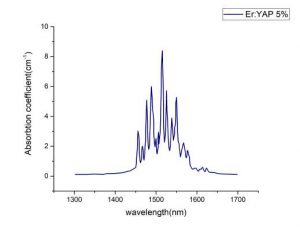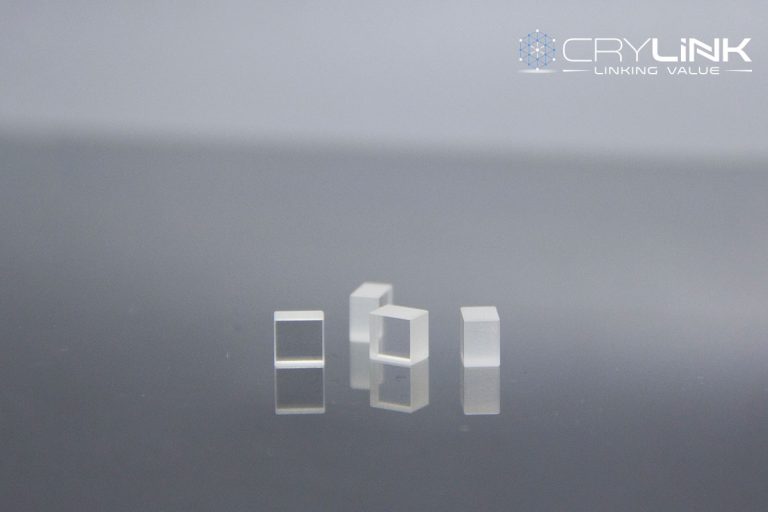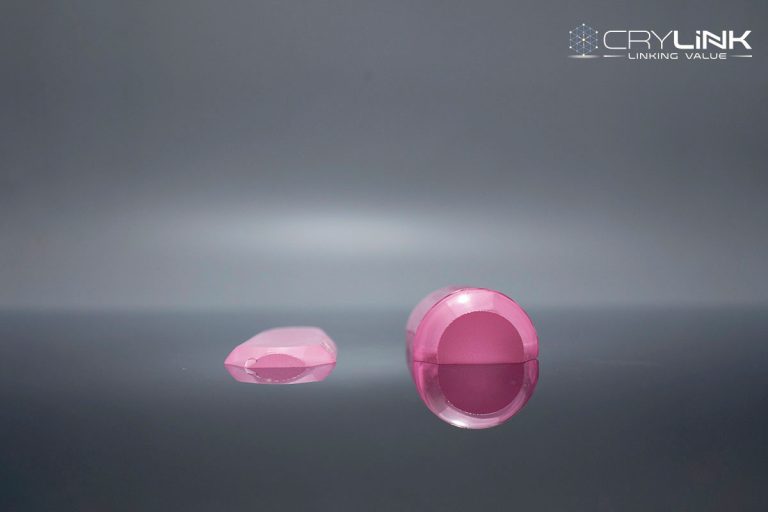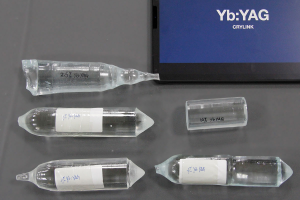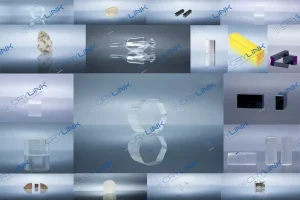Er: YAP
Er:YAP Crystal for 3790-3000nm Laser
Size: 2*5*8mm, 10*10*3mm;
Coating: AR/AR@960- 980nm&2700-3000nm,R<1.5%
Er:YAP Crystal case (2)
Size: 2×5×8 mm;
Both apertures: Flat, optical polished, uncoated
Er:YAP Crystal case (3)
Random orientation;
Dimension: 2.5*2.5*33 mm;
6-side inspection polishing
Emission and excitation spectra of Er-doped YAP crystals reveal a broad emission band in the eyesafe region with peaks around 1545-nm and 1608-nm and pump-bands suitable for common 800-nm and 970-nm diode lasers, suggesting YAP as a candidate crystalline host for diode-pumped laser in the 1.5-μm eyesafe regime.
Yttrium aluminum perovskite (YAP) is expected to be suitable host material for efficient laser emission owing to higher thermal conductivity (∼13.3 W m−1 K−1)) good mechanical properties, and lower photon energy compared to YAG, Y2O3, and Lu2O3) ,Er:YAP exhibits the large emission cross-section in 3 μm, which was three times larger than that of Er:YAG. Highly doped Er:YAP can emit 2.73µm wavelength laser, and lowly doped Er:YAP crystal emits 1.66µm laser. Moreover, Er:YAP is one of the most promising laser materials, and can provide high-power mid-IR coherent beam.
- Higher thermal conductivity
- Lower phonon energy
- Good mechanical properties
- Abundant energy level structure
- High doping concentration
- Eyesafe Glass
- high-power mid-IR coherent beam
| 1.6 µm Er:YAP and Er:YAG Lasers Resonantly Pumped by Er Glass Laser |
| 2.7 μm dual-wavelength laser performance of LD end-pumped Er:YAP crystal |
| 2.92-µm high-efficiency continuous-wave laser operation of diode-pumped Er:YAP crystal at room temperature |
| Comparison of Resonantly Pumped Er:YAG and Er:YAP Lasers |
| Deposition of Er:YAG (YAP) layers by subpicosecond and nanosecond KrF excimer laser ablation |
| Growth and anisotropic spectral properties of Er-YAlO3 crystal |
| Highly efficient Er:YAP laser with 6.9 W of output power at 2920 nm |
If you can’t find the Literature you want, Contact us to get the PDF Get the Literature
| Highly oriented crystalline Er-YAG and Er-YAP layers prepared by PLD and annealing |
| Hydrothermal synthesis and characterization of rare earth doped yttrium aluminum perovskite |
| Hydroxil and iron ions in YAP-Er laser crystals |
| Mode-locking of the 1.66 pm transition of an Er-YAIO3 laser |
| Near-infrared emission bands of Er3þ-doped YAP and LSO crystals |
| Passively Q-switched 2.9 μm ErYAP single crystal laser using graphene saturable absorber |
| Properties of Er-doped layers grown from Er-YAG(YAP) crystalline targets by sub-picosecond laser-deposition |
| Resonantly Pumped Continuous Wave Er-YAP Laser |
| Resonantly Pumped Er-YAG and Er-YAP Lasers |
| Resonantly Pumped Multiwavelength Operation in Er-YAP |
| Spectroscopic properties analyses and laser characterization simulation of Er,Eu-YAP single crystal |
| Strong coupling of an Er3+-doped YAlO3 crystal to a superconducting resonator |
| Temperature influence on Er-YAlO3 spectroscopy and diode-pumped laser properties |
| Thermoluminescence Properties of Doped YAP Crystals |
| Vacuum ultraviolet spectra and crystal field analysis of YAlO3 doped with Nd3+ and Er3+ |
| YAlO3-Er3+ crystal laser |
Parameter
| Chemical Formula | Er:YAlO3 |
| Crystal Structure | orthorhombic – Pbnm |
| Molecular Weight | 163.884 |
| Appearance | Translucent crystalline solid |
| Crystallographic Orientation | b-axis ref. to Pbnm convention |
| Melting Point | 1870 °C |
| Density | 5.35 g/cm3 |
| Specific Heat | 0.557 J/g·K |
| Thermal Conductivity | 11.7 W/m·K (a-axis), 10.0 W/m·K (b-axis), 13.3 W/m·K (c-axis) |
| Thermal Expansion | 2.32 x 10-6 K-1 (a-axis), 8.08 x 10-6 K-1 (b-axis), 8.7 x 10-6 K-1 (c-axis) |
| Exact Mass | 163.872 g/mol |
| Monoisotopic Mass | 163.872 g/mol |
| Laser Transition | 4S3/2→4I9/2 | 4I11/2→4I13/2 |
| Laser Wavelength | 1.66 µm | 2.73 µm |
| Pump bands | 0.6-0.8 µm | 1.53 µm |
| Refractive Index | 1.94-1.97 (@ 632.8 nm) | |
| Emission cross-section | 3 μm | |

